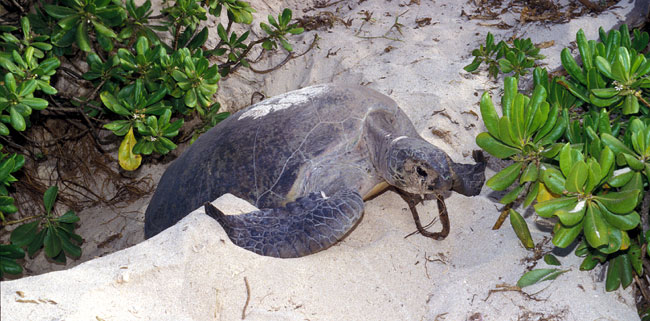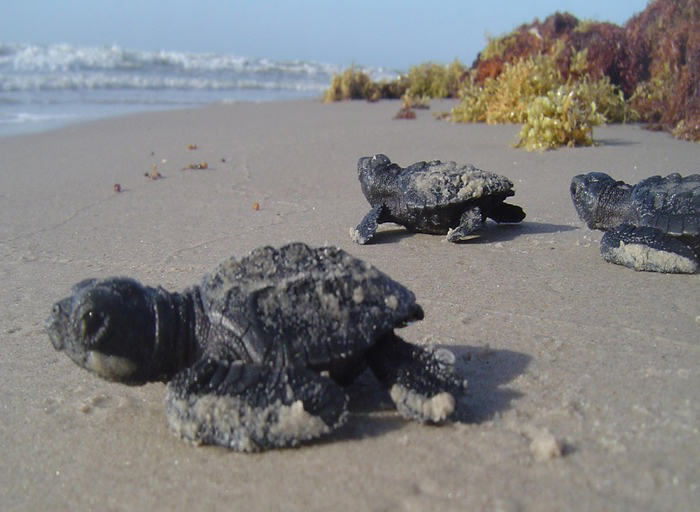| Adult marine turtles migrate long distances for reproduction. Most of the favorite feeding grounds for marine turtles are near coastlines but their primary reproductive sites are on beaches located on remote islands. Marine turtles off Brazil, in the Atlantic Ocean, may migrate over a thousand miles to the center of the Atlantic Ocean to breed on Ascension Island (midway between Brazil and Africa). It is believed that marine turtles return to the same beach where they hatched many years before. |
| Marine turtles begin reproducing at a rather old age. Most species will not reproduce until they are 15-50 years old. Not much is known about the first fifteen years of a marine turtle's life. It is rare that they are sited. Most people believe that the babies are easy prey for big fish and sharks in the ocean and that it is only the ones who hide in seaweed patches who are able to survive. By hiding in drifting seaweed (or trash in some cases) the young turtles are not easy to spot by their predators as well as curious humans. |
| Male and female couples are seen mating in the ocean near beaches. This is usually during a certain couple of months each year. Specific beaches are known for their particular seasons and species of reproducing marine turtles. This makes the study of marine turtle reproduction quite easy as trips to specific beaches can be planned knowing there will be reproducing turtles during certain months each year. Males generally do not leave the water but all the nesting females do. Tagging female marine turtles is quite easy for this reason so most of the migration information comes from females. It is hard to tag a male marine turtle. Almost all the turtle reproduction beaches are in the tropics. |
Female green turtle leaving the ocean to nest. (GA image) |
| Females leave the ocean, usually at night, on particular beaches to lay their eggs. As the females crawl up the beach they leave behind the support of the water around their bodies. They must crawl until they get above the high tide mark. It takes a lot of extra energy for these females to make it all the way to the berm crest area (sandy beach area of highest high tide waves) as they are not used to the effects of gravity on land. It may take several hours for them to travel a short 30 feet. |
Female turtle digging body pit with flippers (left) with sand flying everywhere (right). (GA images) |
| A body pit is dug above the high tide line by the nesting female. This activity appears to be uncoordinated as the female begins digging (after she has rested from traveling up the beach from the ocean). All flippers dig sand and fling it in all directions. Eventually a body pit is dug which is a depression putting her body below grade. It may be twice as wide as her shell when she is done. This may take several hours and is followed by another rest. |
Female turtle in body pit covered with sand (left). Female turtle head showing eye with tears washing sand away from her eyes (right). (GA images) |
| Sand may cover the female for a time as she finishes digging her body pit. She may have sand covering her head and eyes. Marine turtle females have copious tears to wash the sand from their eyes. It may look like she is crying but this is just an adaptation to keep her eyes free of sand. |
Female beginning to lay eggs in brood chamber (left). Female laying eggs in brood chamber (top right) and close-up of eggs (bottom right). (GA images) |
Brood chambers are carefully excavated by the female in the bottom of her body pit. She digs these only with the use of her hind flippers. Each flipper scoops some sand, just under her tail, crooking the end of the flipper so that it holds a scoop of sand. Then she maneuvers the sand away from the brood chamber and dumps it. This is a very controlled activity and quite different from the digging of the body pit. After an hour or two a pear-shaped hole is dug under her tail. The bottom of the brood chamber is about a foot deep and is the widest part of the pear-shaped chamber. Again, the female marine turtle rests.
Eggs are laid in the brood chamber. When egg laying starts it is usually a rather quick event. About 100 eggs are laid one by one, one after the other, falling into the brood chamber. Each egg is about the size of a golf ball and has a leathery covering so they do not break as they fall. Once the female has started laying eggs she seems to be insensitive to any activity around her. Even if there are loud noises and lots of movement she will continue her nesting behavior without interruption. However, before she begins laying her eggs she may be easily disturbed and abandon her nesting behavior even after leaving the ocean, crawling up the beach, digging the body pit, and digging the brood chamber. On beaches where scientists and tourists watch the females little or no disturbance to the beginning part of the nesting procedure is highly encouraged. |
 |
Female green turtle leaving her nest after laying her eggs and covering them with sand. (GA image) |
| Females cover their brood chamber and body pit with sand before they return to the ocean. Females carefully pat the sand on top of their brood chamber and then start flipping the sand wildly to fill in and obscure their body pit. If other females have used their beach in previous nights a nesting female may actually be digging up eggs laid by previous females that season. |
Sunrise on a turtle nesting beach showing lots of activity from the night before. (GA image) |
| The beach is a mess above the high tide line after a night of marine turtle nesting. This is especially true on beaches where the population of nesting marine turtles is high. |
Female turtle on her way back to the ocean after nesting. (GA image) |
| Returning to the ocean may be a long and difficult trip. When nesting is complete the female will begin the trip back to the ocean. This may be easy if the tide is rather high and it is still night. But, if the tide is low the trip may be much farther and the female may get very tired after her nesting exertion. Most nesting activities are completed during the night and the females return to the ocean under cover of darkness when it is cool. If a female has started late, or taken a particularly long time with her nesting activities she may be returning to the ocean in the morning as the sun is rising and the heat from the sun may make her trip much more difficult. |
Marine turtle tracks left on a sandy beach, note the line in the middle of the tracks left by the tail. (SA image) |
| Females may return only every other year (or two) for reproduction. It is not agreed upon as to whether the mating activity seen near the beaches is for the eggs laid that year or whether females store the sperm and hold the fertilized eggs for another year or two. It is known that female marine turtles do store sperm for several years although its fertility decreases with time. To most scientists the state of the eggs, when they are laid on the beach, is too advanced for it to have come from mating just a few days before. |
Female turtle reaching the ocean at sunrise across the sand. (GA image) |
| After a night of nesting the cool ocean is a welcome relief for the females. It is not just the coolness of the ocean but it is also the support that the water gives to the body of the female. She is very tired after her ordeal on land. Females may return several times each season to nest on the same beach. |
Female turtle returning to the ocean at low tide with reef exposed (left). Female turtle finally making it to the cool ocean over the reef (right). (SA images) |
| Sometimes the tide may be so low that the returning females must crawl over a part of the solid reef to get to the water - a much harder activity than just crawling down the sandy beach. |
Marine turtle tracks ending when the tide was up. (SA image) |
| Turtle tracks on the beach are easily observed the next morning. If the tide has come and gone it may have washed away some of the tracks. |
Baby turtles hatching. (NPS image) |
Baby turtles hatch after a month or two. When the baby turtles are mature and have used up the yolk in their egg (the food for their development) they peck their way out of their egg case. To get out of their egg case they use an "egg tooth" which is on the tip of their mouth. This is lost after they hatch (turtles do not have teeth) but has a unique one-time-only purpose. In most cases the babies hatch at night, crawl to the surface, orient to the ocean and crawl to the water. In some cases the babies hatch in the day and they may go to sleep until it is night before they emerge from the sand. Sometimes the babies emerge in the middle of the day and then they are easy prey for birds flying over the beaches. Once in the water the babies are prey for fish anyway but the trip from their nest to the water in the day may leave only two percent of the original young turtles to begin their life in the ocean.
Sex ratios of marine turtle eggs depend on incubation temperature. It is the temperature of the incubating eggs that will determine what sex the marine turtles will be. This is quite different from most animals. Cooler incubation temperatures will produce all males and warmer incubation temperatures will produce all females. Some tropical turtle nesting islands have a 'warm' side and a 'cool' side and produce different sexes from different sides of the island.
Only a few baby turtles survive to adulthood. Although females may lay about 100 eggs 50 or more times in their lives, it would be unusual for more than 2-3 of them to actually make it to adulthood and return to the beach to reproduce. This makes the protection of endangered marine turtles and their nesting beaches a priority for many countries. |
|


